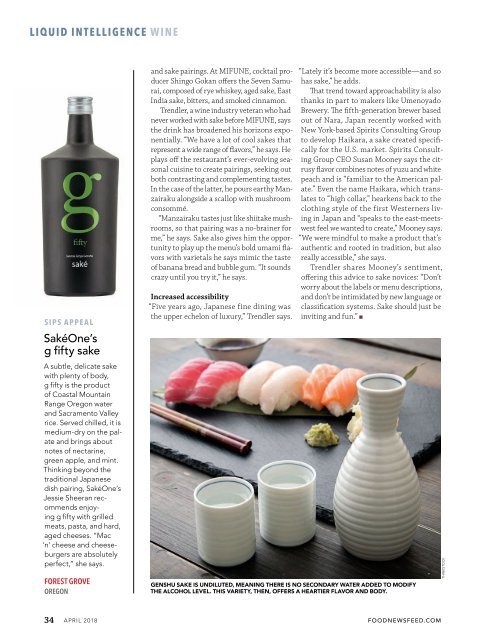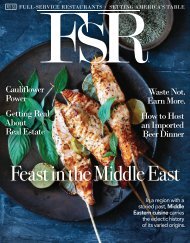FSR magazine April 2018
You also want an ePaper? Increase the reach of your titles
YUMPU automatically turns print PDFs into web optimized ePapers that Google loves.
LIQUID INTELLIGENCE WINE<br />
SIPS APPEAL<br />
SakéOne’s<br />
g fifty sake<br />
A subtle, delicate sake<br />
with plenty of body,<br />
g fifty is the product<br />
of Coastal Mountain<br />
Range Oregon water<br />
and Sacramento Valley<br />
rice. Served chilled, it is<br />
medium-dry on the palate<br />
and brings about<br />
notes of nectarine,<br />
green apple, and mint.<br />
Thinking beyond the<br />
traditional Japanese<br />
dish pairing, SakéOne’s<br />
Jessie Sheeran recommends<br />
enjoying<br />
g fifty with grilled<br />
meats, pasta, and hard,<br />
aged cheeses. “Mac<br />
‘n’ cheese and cheeseburgers<br />
are absolutely<br />
perfect,” she says.<br />
FOREST GROVE<br />
OREGON<br />
and sake pairings. At MIFUNE, cocktail producer<br />
Shingo Gokan offers the Seven Samurai,<br />
composed of rye whiskey, aged sake, East<br />
India sake, bitters, and smoked cinnamon.<br />
Trendler, a wine industry veteran who had<br />
never worked with sake before MIFUNE, says<br />
the drink has broadened his horizons exponentially.<br />
“We have a lot of cool sakes that<br />
represent a wide range of flavors,” he says. He<br />
plays off the restaurant’s ever-evolving seasonal<br />
cuisine to create pairings, seeking out<br />
both contrasting and complementing tastes.<br />
In the case of the latter, he pours earthy Manzairaku<br />
alongside a scallop with mushroom<br />
consommé.<br />
“Manzairaku tastes just like shiitake mushrooms,<br />
so that pairing was a no-brainer for<br />
me,” he says. Sake also gives him the opportunity<br />
to play up the menu’s bold umami flavors<br />
with varietals he says mimic the taste<br />
of banana bread and bubble gum. “It sounds<br />
crazy until you try it,” he says.<br />
Increased accessibility<br />
“Five years ago, Japanese fine dining was<br />
the upper echelon of luxury,” Trendler says.<br />
“Lately it’s become more accessible—and so<br />
has sake,” he adds.<br />
That trend toward approachability is also<br />
thanks in part to makers like Umenoyado<br />
Brewery. The fifth-generation brewer based<br />
out of Nara, Japan recently worked with<br />
New York-based Spirits Consulting Group<br />
to develop Haikara, a sake created specifically<br />
for the U.S. market. Spirits Consulting<br />
Group CEO Susan Mooney says the citrusy<br />
flavor combines notes of yuzu and white<br />
peach and is “familiar to the American palate.”<br />
Even the name Haikara, which translates<br />
to “high collar,” hearkens back to the<br />
clothing style of the first Westerners living<br />
in Japan and “speaks to the east-meetswest<br />
feel we wanted to create,” Mooney says.<br />
“We were mindful to make a product that’s<br />
authentic and rooted in tradition, but also<br />
really accessible,” she says.<br />
Trendler shares Mooney’s sentiment,<br />
offering this advice to sake novices: “Don’t<br />
worry about the labels or menu descriptions,<br />
and don’t be intimidated by new language or<br />
classification systems. Sake should just be<br />
inviting and fun.”<br />
GENSHU SAKE IS UNDILUTED, MEANING THERE IS NO SECONDARY WATER ADDED TO MODIFY<br />
THE ALCOHOL LEVEL. THIS VARIETY, THEN, OFFERS A HEARTIER FLAVOR AND BODY.<br />
THINKSTOCK<br />
34 APRIL <strong>2018</strong> FOODNEWSFEED.COM



